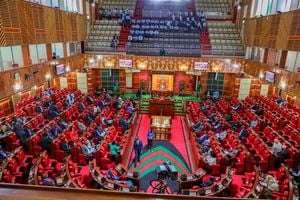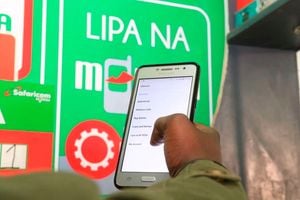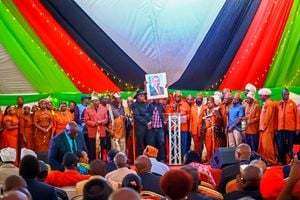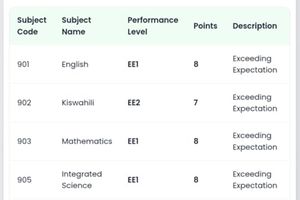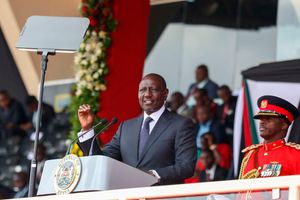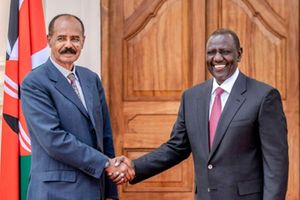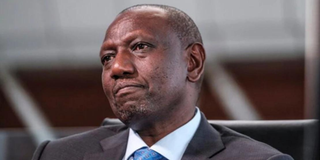
President William Ruto.
It seemed President William Ruto had reason for cheer on concluding a triumphant State Visit to the United States where he was feted by the White House and secured aid and trade deals worth billions of shilling.
Then he came home to a bumpy landing, the headaches that might have been out of sight and out of mind as he enjoyed American hospitality. He found the raging fire in the governing Kenya Kwanza coalition around his fractured relations with Deputy President William Rigathi Gachagua threatening to blow out of control.
He was also faced with growing public anger over draconian tax proposals in the 2024 Finance Bill that were uniting everybody from the lowly mama mboga and hustler upwards to the captains of commerce and industry against measures many felt would kill business.
As if the big issues that could have a direct impact on the stability of his administration and 2027 re-election prospects were not enough, President Ruto was also forced to explain himself on the cost of his luxury chartered jet to the US. First, he came out with a message on X, formerly Twitter, saying that it came at less cost than would have been had he used the national carrier, Kenya Airways.
Then at the National Prayer Breakfast a few days later, Thursday last week, he felt constrained to explain himself further, volunteering that unidentified ‘friends’ had heard he intended to use Kenya Airways, and offered him the luxury jet at a steep discount, a mere Sh10 million. That was far less than the figures approaching Sh200 million, which media had estimated, and even less than the quotations of some Sh70 million which his office had received.
The President told the gathering that he was not a ‘madman’ to spend the kind of sums written about, explaining that when it came to his pleas on frugality and belt-tightening, he leads form the front. Later that evening, State House seemed to have realised that the President’s explanation had left too many gaps.
Spokesman Hussein Mohamed thus released an official statement clarifying that the government of the United Arab Emirates had provided the jet at a relatively low cost. To illustrate that there was nothing untoward, he gave examples where the UAE and other friendly governments had extended military and other forms of aid. “This is how nations operate, supporting and partnering with each other for mutual prosperity”, the statement concluded.
The explanations from Ruto and his State House spokesman left more questions than answers. The media — newspapers, TV, radio and Internet — was abuzz with debate, many questioning the wisdom of the president accepting such ‘gifts’ from foreign entities who might want something in return.
There was pending questions on whether the benefactor was the UAE government or private entities, whether the constitutional and legal restrictions on State officers soliciting or receiving gifts were adhered to, and also whether the public procurement laws were flouted since there was an expense to the public purse.
The President’s explanation had also suggested that he was initially willing to use Kenya Airways for lack of alternative, until the ‘friend’ heard of his predicament and offered a cheaper and better option.
That not only demonstrated a lack of trust in the national airline, but also raised questions on how a foreign entity got privileged insider information on President Ruto’s travel plans. The incident exposed not just incoherent messaging, but also faulty decision-making that opens up the President to all sorts of questions. Yet that episode must be small fry to the bigger challenges the President must confront. One of the Finance Bill that has stirred up hostility could even eclipse opposition to the 2023 version.
Ruto’s first budget since assuming office in 2022 earned him the nickname ‘Zakayo’ after the biblical tax collector. It opened the window for opposition forces led by defeated presidential candidate Raila Odinga to stage a series of often violent street protests that only eased after a deal was brokered national dialogue.
The outcome was the report of a National Dialogue Committee that is still pending in Parliament. In the meantime, Raila eased-of attacks on government as he sought backing in his quest for chairmanship of the African Union Commission, leaving the opposition Azimio alliance without a motive force to keep pressure on government.
The other Azimio leaders, Kalonzo Musyoka of Wiper Party, Martha Karua Narc Kenya, Eugene Wamalwa of DAP and even Raila lieutenants in the dominant ODM such as Hassan Joho, Opiyo Wandayi and John Mbadi have been threatening to organise fresh rounds of street protests if the unpopular tax proposals are not revoked.
Ruto, however, has a respite on that one as long as Raila is effectively neutralised and none of the other opposition chiefs has the force has capacity to mobilise crowds in any substantial way. But in the long term, the president still has to contend with the realty that on perceptions of oppressive taxation and high cost of living amidst executive profligacy, the buck stops with him. He expresses confidence that that painful measures he has taken to raise revenues, meet debt burdens and keep the government afloat will eventually pay off, but if he could pay a heavy price if turnaround does not happen soon and he loses the suffering underclass base that propelled him to electoral victory.
He is no doubt aware that the rumblings of discontent are everywhere. That is why he recently sought to assuage public anger by slashing the mystery ‘confidential’ monies allocated his office, Gachagua, Prime Cabinet Secretary Musalia Mudavadi, and other key offices. He asked the National Treasury to cut his confidential vote of Sh1.4 billion to Sh600 million, the DPs from Sh1.2 billion to Sh320 million, and the Prime CS from Sh300 million to Sh150 million.
Chief of Staff Felix Koskey had his vote cut from Sh100 million to Sh40 million. While that might seem a big sacrifice, it brought to public attention that key Kenyan leaders have traditionally been awarded what can only be equated to slush funds from the public kitty which apparently are not for any specific office expenses and are out of reach of the audit process. In any case the public concern is more about the cost of bread.
Then there is Gachagua. The two looked cordial enough seated together at the National Prayer breakfast. The DP, better known for his stern demeanour and perpetual combative mien displayed a rare sense of humour in cracking jokes about Ruto walking hand-in-hand with First Lady Rachel Ruto whilst in the US.
He said the images had out him and other pleaders under pressure from their spouses to emulate the president, and wanted assurance that those foreign habits had been left in the US.
Those light moments do not disguise the challenge at hand. Gachagua has made it public, direct and through proxies, that he will not take disrespect or mistreatment from the president lying down. In accusing politicians close to the president of undermining him, the DP has thrown down the gauntlet and Ruto must sooner or later pick it up.
He could call of his presumed attack dogs for now, whether those be figures like Public Service Cabinet Secretary Moses Kuria or Kiharu MP Ndindi Nyoro from the DP’s Mt Kenya backyard; Roads CS Kipchumba Murkomen and Kapseret MP Oscar Sudi from his own north Rift Valley stronghold, or even the State House keyboard warriors led by digital strategist Dennis Itumbi.
But even that will be simply papering over the cracks in a situation where Gachagua’s allies are threatening to review Mt Kenya political options, read support for Ruto’s 2027 re-election bid.
Ruto’s loyalists in turn accuse the DP of trying to blackmail the President. What is clear is that Ruto was elected on the strength of a solid Rift Valley-Mt Kenya vote, supplemented by what came from the Mudavadi and National Assembly Moses Wetang’ula in western Kenya, and smattering of votes elsewhere.
Ruto knows that he cannot afford to ditch that alliance, and therefore he must retain a Mt Kenya running mate. The big question amongst his strategists is whether it must be Gachagua, or if he can safely be shunted aside and replaced by with a figure such as Ndindi Nyoro, who is apparently being encouraged to test the waters, or Kirinyaga Governor Ann Waiguru.
The risk here is that if there are clear signs in the run-up to 2027 that Gachagua will be dropped from the ticket, he will not play possum. The forceful and aggressive character will fight back, and at the critical time could very likely respond by walking out of UDA and mounting his own presidential bid.
Even if he might not stand a chance of winning, Gachagua could conceivably pick up enough of the populous Mt Kenya vote to fatally eat into the Ruto basket, tilting the balance to whoever the Azimio coalition fields. Of course there are many imponderables. The Mt Kenya forces in Azimio led by Martha Karua, Raila’s 2022 running mate, are also determined to field a candidate. Musyoka and Wamalwa are also examining a joint ticket.
There is still uncertainty om whether Raila will re-enter the fray. On the Kenya Kwanza side, Mudavadi is watching the fracture with interesting, maybe wondering if Ruto will dispense with Gachagua and tap him as the running mate, which would see him bring in the substantial western Kenya vote. That is also calculation being worked it, but it would dash Mt Kenya hopes for the seat and presumed 2027 succession leading to mass exodus.
But what if Raila’s troops were brought into the fold? Ruto going for his final term with Mudavadi as running mate and Raila or his Nyanza region nominee as designated Prime Minister could be an alliance that counters Mt Kenya’s numerical superiority, especially if the populous region is split between two rival presidential candidates in Gachagua and Karua. These are just some of the permutations being worked. While there is nothing clear yet in the fluid situation, Ruto’s strategists are out to cover all bases.

